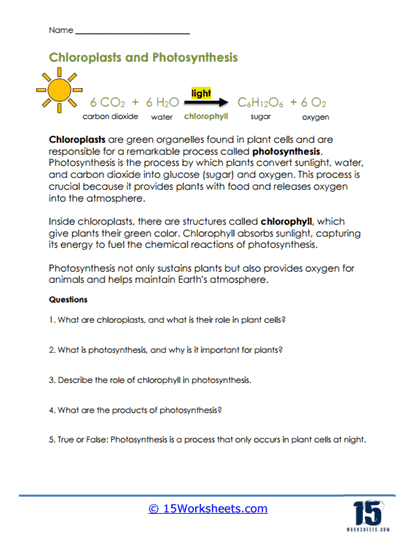Chloroplasts and Photosynthesis

Worksheet Description
This worksheet explores the connection between chloroplasts and the vital process of photosynthesis in plant cells. Chloroplasts, the green organelles in plants, house structures called chlorophyll, which captures sunlight to facilitate the photosynthetic process. Through photosynthesis, plants convert carbon dioxide, water, and sunlight into glucose and oxygen, a process pivotal not just for plant sustenance but also for oxygenating Earth’s atmosphere. The material underscores the dual role of chloroplasts in both giving plants their green hue and acting as the central hub for photosynthesis.
To proficiently tackle this worksheet, students should commence by meticulously reading the provided content on chloroplasts and photosynthesis, grasping the intricate interplay between them. Armed with this knowledge, they can shift their focus to the questions, crafting answers that are both accurate and reflective of the worksheet’s content. As they ponder each question, revisiting and referencing the main text will bolster their understanding and enable more insightful answers. The ultimate goal is to synthesize the knowledge presented and apply it meaningfully to the questions posed.
The overarching aim of this worksheet is to impart a comprehensive understanding of the fundamental role of chloroplasts in photosynthesis and the broader implications of this process for life on Earth. By elucidating the function of chlorophyll and the mechanics of photosynthesis, students glean how plants both nourish themselves and contribute to the planet’s oxygen supply. The subsequent questions seek to reinforce this knowledge, encouraging students to reflect on, analyze, and articulate their understanding of these biological phenomena. Through this exercise, students are primed for a deeper exploration of plant biology and the symbiotic relationship between flora and the environment.
